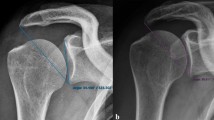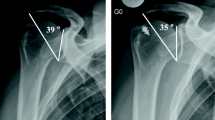Abstract
Background
The acromion index (AI), critical shoulder angle (CSA) and lateral acromion angle (LAA) are predictive for degenerative rotatory cuff tears. Their unfavorable values are associated with a suboptimal deltoid force vector. The aim of this study was to evaluate whether an optimization of the radiological parameters could be achieved through a specific arthroscopic lateral acromion resection (ALAR).
Materials and methods
The procedure was performed in eight fresh frozen cadaver shoulders. True a.p. and axial radiographs were taken before and after the intervention for radiological evaluation. The anterior and posterior acromion edges were marked with a spinal needle. Then 1 cm of the lateral acromion was resected with a 5.0 acromionizer (Arthrex Inc., Naples, FL, USA) beginning from the anterior aspect. The resection was completed over the total width of 1 cm from anterior to posterior. Finally the deltoid insertion was dissected via an open approach to ensure its integrity. The fluoroscopy images were evaluated regarding the pre- and postinterventional parameters AI, CSA and LAA.
Results
After the intervention, the mean AI could be significantly reduced from 0.62 ± 0.11 to 0.40 ± 0.15 (p = 0.012). Also the mean CSA was significantly reduced from 35.0° ± 7.65° to 25.12° ± 8.29° (p = 0.018). The LAA could not be significantly changed (76.5° ± 14.02° vs. 82.13 ± 8.93; p = 0.107). There was no injury to the deltoid insertion.
Conclusion
The radiographic parameters AI und CSA can be optimized significantly by ALAR without macroscopic discontinuity of the deltoid insertion.
Level of evidence
Level IV, case series without comparison group.





Similar content being viewed by others
References
Bedi A, Maak T, Walsh C et al (2012) Cytokines in rotator cuff degeneration and repair. J Shoulder Elb Surg 21:218–227. doi:10.1016/j.jse.2011.09.020
Ko JY, Huang CC, Chen WJ et al (2006) Pathogenesis of partial tear of the rotator cuff: a clinical and pathologic study. J Shoulder Elb Surg 15:271–278. doi:10.1016/j.jse.2005.10.013
Chaudhury S, Carr AJ (2012) Lessons we can learn from gene expression patterns in rotator cuff tears and tendinopathies. J Shoulder Elb Surg 21:191–199. doi:10.1016/j.jse.2011.10.022
Neer CS (1983) Impingement lesions. Clin Orthop Relat Res. doi:10.1097/00003086-198303000-00010
Bigliani L, Morrison D, April E (1986) The morphology of the acromion and its relationship to rotator cuff tears. Orthop Trans 10:216
Banas MP, Miller RJ, Totterman S (1995) Relationship between the lateral acromion angle and rotator cuff disease. J Shoulder Elb Surg 4:454–461. doi:10.1016/S1058-2746(05)80038-2
Wong AS, Gallo L, Kuhn JE et al (2003) The effect of glenoid inclination on superior humeral head migration. J Shoulder Elb Surg 12:360–364. doi:10.1016/S1058-2746(03)00026-0
Nyffeler RW, Werner CML, Sukthankar A et al (2006) Association of a large lateral extension of the acromion with rotator cuff tears. J Bone Joint Surg Am 88:800–805. doi:10.2106/JBJS.D.03042
Moor BK, Bouaicha S, Rothenfluh DA et al (2013) Is there an association between the individual anatomy of the scapula and the development of rotator cuff tears or osteoarthritis of the glenohumeral joint? A radiological study of the critical shoulder angle. Bone Jt J 95B:935–941. doi:10.1302/0301-620X.95B7.31028
Gerber C, Snedeker JG, Baumgartner D, Viehöfer AF (2014) Supraspinatus tendon load during abduction is dependent on the size of the critical shoulder angle: a biomechanical analysis. J Orthop Res 32:952–957. doi:10.1002/jor.22621
Moor BK, Wieser K, Slankamenac K et al (2014) Relationship of individual scapular anatomy and degenerative rotator cuff tears. J Shoulder Elb Surg 23:536–541. doi:10.1016/j.jse.2013.11.008
Balke M, Schmidt C, Dedy N et al (2013) Correlation of acromial morphology with impingement syndrome and rotator cuff tears. Acta Orthop 84:178–183. doi:10.3109/17453674.2013.773413
Kitay GS, Iannotti JP, Williams GR et al (1995) Roentgenographic assessment of acromial morphologic condition in rotator cuff impingement syndrome. J Shoulder Elb Surg 4:441–448. doi:10.1016/S1058-2746(05)80036-9
Aoki M, Ishii S, Usui M (1986) The slope of the acromion and rotator cuff impingement. Orthop Trans 10(2):228–235
Balke M, Banerjee M, Vogler T et al (2014) Acromial morphology in patients with calcific tendinitis of the shoulder. Knee Surg Sport Traumatol Arthrosc 22:415–421. doi:10.1007/s00167-012-2327-5
Kim JR, Ryu KJ, Hong IT et al (2012) Can a high acromion index predict rotator cuff tears? Int Orthop 36:1019–1024. doi:10.1007/s00264-012-1499-4
Miyazaki AN, Itoi E, Sano H et al (2011) Comparison between the acromion index and rotator cuff tears in the Brazilian and Japanese populations. J Shoulder Elb Surg 20:1082–1086. doi:10.1016/j.jse.2011.04.028
Torrens C, López JM, Puente I, Cáceres E (2007) The influence of the acromial coverage index in rotator cuff tears. J Shoulder Elb Surg 16:347–351. doi:10.1016/j.jse.2006.07.006
Melean P, Lichtenberg S, Montoya F et al (2013) The acromial index is not predictive for failed rotator cuff repair. Int Orthop 37:2173–2179. doi:10.1007/s00264-013-1963-9
Acknowledgments
The authors would like to thank Arthrex® Inc. (Naples, Florida) for the support during the study.
Author information
Authors and Affiliations
Corresponding author
Ethics declarations
Conflict of interest
The authors report the following potential conflicts of interest or source of funding: S. Greiner and M. Kääb are consultants for Arthrex®. The authors, their immediate families, and any research foundation with which they are affiliated did not receive any financial payments or other benefits from any commercial entity related to the subject of this article.
Rights and permissions
About this article
Cite this article
Altintas, B., Kääb, M. & Greiner, S. Arthroscopic lateral acromion resection (ALAR) optimizes rotator cuff tear relevant scapula parameters. Arch Orthop Trauma Surg 136, 799–804 (2016). https://doi.org/10.1007/s00402-016-2431-y
Received:
Published:
Issue Date:
DOI: https://doi.org/10.1007/s00402-016-2431-y




